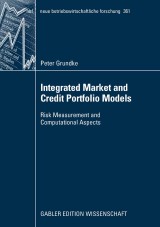Details

Integrated Market and Credit Portfolio Models
Risk Measurement and Computational Aspectsneue betriebswirtschaftliche forschung (nbf), Band 361
|
53,49 € |
|
| Verlag: | Gabler |
| Format: | |
| Veröffentl.: | 15.08.2008 |
| ISBN/EAN: | 9783834996893 |
| Sprache: | englisch |
| Anzahl Seiten: | 188 |
Dieses eBook enthält ein Wasserzeichen.
Beschreibungen
Banks are exposed to various kinds of risks; among them are credit default risks, market price risks and operational risks the most important ones. Aggregating these different risk ex- sures to a comprehensive risk position is an important, yet challenging and up to now un- solved task. Banks’ current state of the art in risk management is still far away from achieving a fully integrated view of the risks they are exposed to. This shortfall traces back to both, to conceptual problems of constructing an appropriate risk model and to the computational b- den of calculating a loss distribution. The approach presented in this book takes credit default risk as a starting point. By integrating market risks, a general credit risk model is constructed that comprises the standard industry credit risk models as special cases. Within the framework of this general credit risk model, the effects of simplifying assumptions that are typical for standard credit risk models can be a- lyzed. Important insights gained by this analysis are that neglecting market price risks and losses given default correlated to default rates can cause a significant understatement of value at risk figures.
The Integrated Market and Credit Portfolio Model.- Effects of Integrating Market Risk into Credit Portfolio Models.- On the Applicability of Fourier-Based Methods to Integrated Market and Credit Portfolio Models.- Importance Sampling for Integrated Market and Credit Portfolio Models.- Conclusions.
PD Dr. Peter Grundke habilitierte am Seminar für Allgemeine Betriebswirtschaftslehre und Bankbetriebslehre der Universität zu Köln.<br>
Er leitet zur Zeit das Fachgebiet Finance an der Universität Osnabrück.<br>
Er leitet zur Zeit das Fachgebiet Finance an der Universität Osnabrück.<br>
Due to their business activities, banks are exposed to many different risk types. Aggregating various risk exposures to a comprehensive risk position is an important but up-to-date not satisfactorily solved task. This shortfall goes back to conceptual problems of constructing an appropriate risk model and to the computational burden of determining a loss distribution that comprises all relevant risk types.<br>
<br>
Peter Grundke deals with both problems. On the one hand, he extends a standard credit portfolio model by correlated interest rate and credit spread risk. The analysis shows that the economic capital needed as a buffer to absorb unexpected losses in a portfolio can be severely underestimated when relevant market risk factors are neglected. On the other hand, computational aspects are addressed. Particularly those problems are discussed which arise when computational tools developed for standard portfolio models are applied to integrated market and credit portfolio models.<br>
<br>
<br>
Peter Grundke deals with both problems. On the one hand, he extends a standard credit portfolio model by correlated interest rate and credit spread risk. The analysis shows that the economic capital needed as a buffer to absorb unexpected losses in a portfolio can be severely underestimated when relevant market risk factors are neglected. On the other hand, computational aspects are addressed. Particularly those problems are discussed which arise when computational tools developed for standard portfolio models are applied to integrated market and credit portfolio models.<br>
<br>
Due to their business activities, banks are exposed to many different risk types. Aggregating various risk exposures to a comprehensive risk position is an important but up-to-date not satisfactorily solved task. This shortfall goes back to conceptual problems of constructing an appropriate risk model and to the computational burden of determining a loss distribution that comprises all relevant risk types.<br>
<br>
Peter Grundke deals with both problems. On the one hand, he extends a standard credit portfolio model by correlated interest rate and credit spread risk. The analysis shows that the economic capital needed as a buffer to absorb unexpected losses in a portfolio can be severely underestimated when relevant market risk factors are neglected. On the other hand, computational aspects are addressed. Particularly those problems are discussed which arise when computational tools developed for standard portfolio models are applied to integrated market and credit portfolio models.<br>
<br>
<br>
Peter Grundke deals with both problems. On the one hand, he extends a standard credit portfolio model by correlated interest rate and credit spread risk. The analysis shows that the economic capital needed as a buffer to absorb unexpected losses in a portfolio can be severely underestimated when relevant market risk factors are neglected. On the other hand, computational aspects are addressed. Particularly those problems are discussed which arise when computational tools developed for standard portfolio models are applied to integrated market and credit portfolio models.<br>
<br>
Diese Produkte könnten Sie auch interessieren:

Zur Begründung eines progressiven Einkommensteuertarifs aus der Perspektive der Gleichmäßigkeit der Besteuerung

von: Mark Heitfeldt

59,99 €

Municipal Finances and the Adoption of Participatory Budgeting in Germany

von: Janina Apostolou

96,29 €














